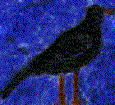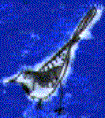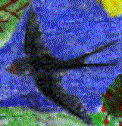
St. Kilian
St. Kilian’s N.S.

St. Kilian
|
St. Kilian |
St. Kilian’s N.S. |
St. Kilian |
|
Nature
News
Birds
|
|||
 |
The Robin by Darren, Thomas and Luke
The robin
is a plump and perky bird with long slender legs.
It has a pointed beak. The
robin has a white face and a red belly.
It has not a very long tail. |
|||
| The
robin has an alarming song. You
would find it mostly in winter outside a house or in a garden looking for
something to eat. We have lots of
robins around our school. |
||||
The Blackbird by Darren, Thomas and Luke
The blackbird
has an orange beak and a large tail.
It has big eyes. The male
is glossy jet black all over, and the female has a brown coat. |
 |
|||
|
The blackbird
is a woodland bird and a farmland bird.
The blackbirds find worms and grubs in the soil and eat fruits
and berries in the autumn. The
nests are open cups, built in bushes.
The hen does most of the nest building and sits on the eggs, but
both parents feed the young. We have lots
of blackbirds around our school. We
think a pair of blackbirds has built their nest in a bush outside our
classroom window. |
||||
 |
The Rook / The Crow by Eimear and Michael Rooks
are often called crows. Rooks
are mainly black and they have grey beaks. They
eat insects. Rooks search for
food in fields, parks and gardens. |
|||
|
Rooks nest
in tall trees. The female rook
lays three to five eggs. She sits
on the eggs for sixteen to eighteen days.
Both parents feed the young. Rooks stay
around all year. There is a rookery
beside the church near our school. In
spring when the trees are bare we see the rooks flying around with twigs
in their beaks repairing their nests.
We usually find about twenty nests there. |
||||
|
The Song Thrush by Sinead and Stephen |
 |
|||
|
The thrush
eats worms, insect grubs and snails.
Thrushes hammer the snail’s shell with their beaks to open them. The thrush
is territorial. It will chase
other thrushes away from its own area.
The thrush sings nearly all year round. |
||||
 |
The Wagtail by Karen and Sandra Wagtails
live on small insects. They live
where the ground is open and insects are plentiful.
Many wagtails live in cities but the farmyard is the best place
to find them. They come together
in hundreds to sleep in the trees. |
|||
|
The wagtail
is black and has a white breast. Their
long tails and short wings help them to take off quickly. |
||||
|
The Swallow by Thomas, Darren and Luke The swallow
is a migrating bird. It goes to
South Africa in September and returns to Ireland in April. Swallows
are blue black with chestnut faces and black throats. The under parts are white. Swallows
have curved wings and deeply forked tails. |
 |
|||
|
The male
has a longer tail than the female. The
tail has white spots. Swallows
perch on high overhead wires. They
return to the same nest year after year.
The swallow’s nest is usually on a beam or under gutters. It is shaped like a half cup. It is made of mud and straw cemented together. Thomas has swallows high up on the walls of his house and in beside the roof under the gutters. Darren has a swallow’s nest on the gable of his house and under the roof of the shed. |
||||
 |
The Wren by Eimear and Michael The wren
is a fat little bird. It is the
size of your fist. The wren is
a brown bird with a stumpy tail. |
|||
|
Wrens nests
are made of moss and grass and lined with feathers. They are usually placed in holes. The cock wren builds several nests his mate chooses one of these
for the home. You can find
the wren everywhere. The cock
wren has a very loud song and the female has a very quiet song. Wrens
are the second smallest Irish bird. We see wrens
jumping in and out
of the bushes outside our classroom. We think they have a nest there. |
||||
|
The Bluetit by Sinead and Stephen The bluetit
is a small bird. It is about 11
c.m. long. The bluetit has a blue crown, wings and tail.
Its cheeks are white and the under parts are yellow. |
 |
|||
| They are found
in hedges and shrubs and are very common in gardens. They feed on greenfly so gardeners like them.
The nest in holes, sometimes in places such as letterboxes. |
||||
 |
The Bullfinch by Sandra and Karen Bullfinches
are often seen in gardens. They
live among hedges and shrubs. They feed on plants, especially the buds of shrubs such as the hawthorn and the flowers of the willow and oak. |
|||
|
They also eat the buds of fruit crops like apples and currants. Some gardeners cover their apple trees when
the blossom is out to keep the bullfinches away. |
||||